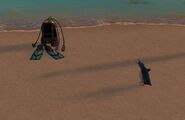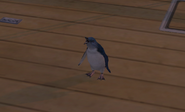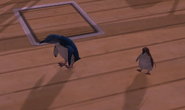← Chinstrap PenguinEndless Ocean Creatures
Endless Ocean 2 CreaturesBrown Booby →
Cape Fur Seal →
The Little Penguin (Eudyptula minor) is a species of penguin, the smallest of all, found in both Endless Ocean and Endless Ocean 2.
It is also sometimes called the "blue penguin" due to its unique bluish feathers. Its scientific name means "good little diver", and it lives up to this - it can swim down to impressive depths for its size.
In-Game[]
Marine Encyclopedia[]
Endless Ocean[]
Description[]
"These birds have small, spindle-shaped bodies and long bills. They are blue-gray on the head and back, and white on the belly and throat. Little penguins will appear on your boat from time to time.
The smallest of all penguins, most of these critters weigh around 2 lbs. They can make a complex series of short and long sounds that are used for communicating with friends, identifying strangers, and marking their territory.
Penguins tend to remain with the same mate for many years. There have even been documented cases of penguins staying together for over a decade."
Endless Ocean 2[]
Description[]
"The smallest of all penguins, weighing just over 1kg. It has long and short calls which can be used to mark territory and communicate with or identify other penguins.
While other species walk upright, this species walks leaning forward and so is thought to be more primitive."
Location[]
Endless Ocean[]
Little penguins occasionally appear on the deck of the Gabbiano after a dive, if the player parks in the Northeastern quadrant of the map. In the months of August, November, February, and May, they can be seen swimming in the water around Comb Reef.
Endless Ocean 2[]
These are seen in Gatama Atoll, around G-5 and H-1, onshore or in the water. They can, however, only be seen in the water during the daytime.
Behavior[]
In the water, little penguins swim about at a rather quick clip. These birds respond positively to being offered food, but the player can more often gain their favor by petting or poking them.
Gallery[]
Notes[]
- This is one of Hayako's favorite creatures, though only when focusing on an adult penguin.
- Should the player sit by the campfire on Nineball Island near sunrise and trigger the credits, there is a probability of a little penguin appearing on the beach alongside Oceana.
Real-Life Information[]
- Endless Ocean's in-game description for the little penguin makes note of penguin mates that stay together for years on end, and little penguins are no exception to this, forming monogamous pairs[1][2]. They start looking for mates when they're about two to three years old[3][4]; If they find little success with breeding, they may seek out new partners[5][6].
- Both in-game descriptions make note of the vocalizations little penguins are known for, and this report is accurate; they use their calls to communicate with friends, foes, and family, as well as during their mating display and to make their territory known[3][6][8].
- The little penguin's behavior in the second Endless Ocean game shows it as diving during the day and being found ashore at night; this is accurate to real life, as little penguins do indeed only leave the water after sunset[7][9][10]. This is to avoid their land-dwelling predators, which are more often active during the day, but could also be to avoid the harsh warmth of the sun[11].
- Both in-game descriptions for this creature describe it as the smallest penguin species, and this much is true[6][9]. The reported weight of about 2 pounds (1 kilogram) is accurate, but they're usually a little bit shorter than the in-game height of 16 inches (41 centimeters), instead reaching from 10-14 inches (25 to 35 centimeters) most of the time[2][12]. They can, however, be up to 17 inches (45 centimeters) tall[1][8].
- The second game says that the little penguin is generally thought to be more primitive, and this much is true[11][13][14][15]. However, whether or not this is because it walks leaning forward is not reported.
- Other common names for the little penguin include blue penguin and little blue penguin, as well as fairy penguin[3][12][16]. All three of these names are owing to its small size, but the first two specifically reference its blue coloration, unique amongst penguins[5].
- During the molting period, while their new feathers are growing in, little penguins cannot float or swim, and so cannot hunt for fish to eat[8]. In order to avoid dying of starvation during their molt, which takes about 2-3 weeks, they eat enough to nearly double their body weight beforehand[5].
- According to the International Union for the Conservation of Nature, the little penguin is a species of least concern, which means that it won't go extinct anytime soon[20]. It was given this classification due to the wide range it inhabits and the lack of a significant decline in overall populations[21].
- Threats include introduced predators, like dogs, as well as penguins being hit by cars or otherwise disturbed by human activity[3][4][9].
- There are concerns that manmade changes are driving little penguins away from some of their old breeding spots and restricting their choices for places to come ashore[10].
- Little penguins are the only species in their genus, Eudyptula[22]. This means that the genus is monotypic, a word used in biology to refer to a taxon that only has one other taxon classified directly underneath it. The scientific name of the little penguin, Eudyptula minor, means "good little diver"[8][17].
- Speaking of dives, the deepest a little penguin has ever gone is 219 feet (66.7 meters)[23]. The previous record was around 187 feet (57 meters), and very few penguins reached below 164 feet (50 meters).
- There are six subspecies of little penguin, and the distinction is in the different geographical ranges in which they come ashore to mate[18][24]. However, some sources do not recognize these as official distinctions[17].
- None of these subspecies are given differentiation in-game.
[]
Emperor Penguin
• Gentoo Penguin
• Adélie Penguin
• Rockhopper Penguin
• African Penguin
Chinstrap Penguin
• Little Penguin
• Cape Fur Seal
• Antarctic Fur Seal
• California Sea Lion
South American Sea Lion
• Steller Sea Lion
• Walrus
• Southern Elephant Seal
• Weddell Seal
Leopard Seal
• Bearded Seal
• Spotted Seal
• Ribbon Seal
• Harp Seal
• Mediterranean Monk Seal
West Indian Manatee
• Razorbill
• Short-Tailed Albatross
• Brown Booby
• Japanese Cormorant
White Pelican
• Australian Pelican
• South Polar Skua
• White-Bellied Parrot
• Polar Bear
• Sea Otter
Galapagos Marine Iguana
References[]
- ↑ 1.0 1.1 1.2 1.3 Blue Penguins Pukekura
- ↑ 2.0 2.1 2.2 Encyclopaedia Britannica
- ↑ 3.0 3.1 3.2 3.3 MarineBio
- ↑ 4.0 4.1 International Penguin Conservation Work Group
- ↑ 5.0 5.1 5.2 Penguin Foundation
- ↑ 6.0 6.1 6.2 Animal Diversity Web (Eudyptula minor)
- ↑ 7.0 7.1 eBird
- ↑ 8.0 8.1 8.2 8.3 Forest & Bird
- ↑ 9.0 9.1 9.2 9.3 New Zealand Department of Conservation
- ↑ 10.0 10.1 10.2 Taranaki Mounga
- ↑ 11.0 11.1 Pinguins
- ↑ 12.0 12.1 Penguin World
- ↑ Aquarium of the Pacific
- ↑ New England Aquarium Penguins Teacher Guide
- ↑ The Origin and Evolution of Birds, Professor Alan Feduccia, pp. 179
- ↑ 16.0 16.1 Project Janszoon
- ↑ 17.0 17.1 17.2 New Zealand Birds Online
- ↑ 18.0 18.1 Avibase
- ↑ Encyclopedia of Ocean Sciences (Second Edition), L.S. Davis
- ↑ IUCN Red List
- ↑ BirdLife International
- ↑ World Register of Marine Species (Genus Eudyptula)
- ↑ "An Exceptionally Deep Dive by a Little Penguin Eudyptula minor"; Yan Ropert-Coudert, Andre Chiaradia, Akiko Kato
- ↑ ITIS Report








